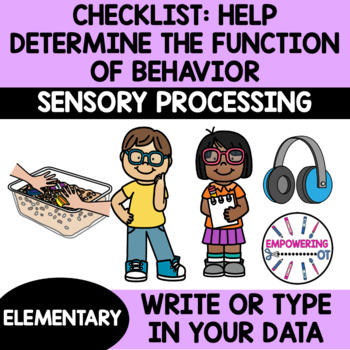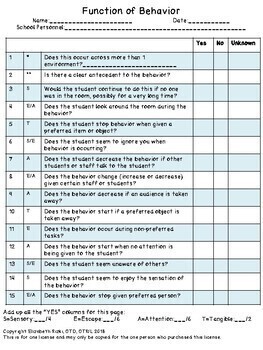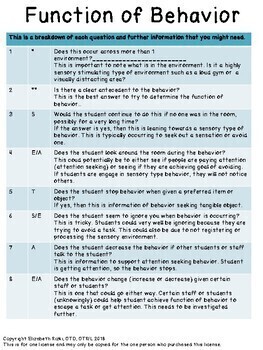HELP determine if SENSORY is function of behavior fillable PDF CHECKLIST OT
- Zip
What educators are saying
Also included in
- This ZIPPED file includes 13 of my sensory motor / self regulation downloads for 170+ pages. This will continue to be updated as appropriate, so get yours now to enjoy additional files! TOOL: 31 questions to determine if SENSORY is function of behavior25 questions for kids to self evaluate SENSORYPrice $39.50Original Price $60.50Save $21.00
- This bundle features all of my sensory processing/self regulation and problem solving resources! This includes 32 of my top selling resources that address sensory processing / self regulation and are perfect for problem solving with teachers & staff. This bundle includes visuals, strategies, hanPrice $100.00Original Price $137.50Save $37.50
- You NEED 150 OCCUPATIONAL THERAPY resources for data tracking, fine motor skills, writing skills, visual motor skills, visual perceptual skills and sensory processing! This includes all my top sellers, and ALMOST my entire store. (I could only get 150 of my resources!) As a bonus file, you get ALLPrice $500.00Original Price $711.00Save $211.00
- If you are starting out as a school occupational therapist, this pack is for you! This is DEEPLY DISCOUNTED and includes resources for data tracking, handouts for teachers, resources for handwriting, scissor skills, fine motor skills, writing skills, visual motor skills, visual perceptual skills anPrice $100.00Original Price $174.50Save $74.50
Description
This is a 31 question tool to HELP determine if SENSORY is the function of behavior. This tool helps to guide WHAT is the function of behavior or WHY is the behavior occurring? Each question is broken down to why things are being asked and with a specific emphasis on explaining each sensory question. You can print and write in your data OR type in your data by filling in the PDF.
This should be only one tool that you use to explore sensory processing and behavior. This is an informal tool that is meant to help guide consultation and look at various behaviors. Trained professionals should use many different tools to look at sensory processing and behavior. This is not intended to treat or diagnose. As a reminder, there can be more than one function of a behavior. What’s included:
•Page 4: Introduction
•Pages 5 is the “SEAT” chart
•Page 6-7 are the 31 questionnaire to guide an informal interview and observation.
•Page 8 is an extra page for notes.
•Page 9 is a place to transcribe answers and total answers. Transfer all answers here. Add up the number to each “Yes”. Once you look at which has the most “yes”, this may give a clue to why the behavior is happening. If there are two close ties, there may be more than one function of behavior.
•Pages 10 – 12 go through each question with more in depth answers at the sensory processing answers.
This is intended to be an INFORMAL TOOL to help guide an informal interview for school personnel to help determine if sensory may be the function or one of the functions of behavior. This can also be an educational tool to help explain to staff WHY they believe a behavior is occurring. This should be used along with your clinical judgement, and standardized measures,
This is perfect to help guide discussions with teachers, staff and other personnel who work with students.
This DOES NOT: diagnose or classify the function of behavior. This can only be done by trained professionals using a variety of different evaluation methods. This cannot be used for every student or every situation.
This is perfect to supplement various social-emotional (SEL) or self regulation program including RTI, MTSS, problem solving, and more.
This is perfect for general education students but also students with Autism spectrum disorder, ADHD, ADD, sensory processing disorder, and other special needs. This can be used with general education, RTI, MTSS, special education, school psychologist, school counselor, occupational therapy OT, speech language pathology SLP, and social work SW.
I am a school occupational therapist who has a doctorate in occupational therapy. I work closely with special education and general education staff adapting material. This is where I get my inspiration for this material. I have used my materials with a variety of children with different disabilities including learning disabilities, dyslexia, autism, sensory processing disorder, ADD, ADHD, visual impairments, deaf/hard of hearing, cerebral palsy, down syndrome and more.
DISCLAIMER: By using this, you agree that this activity is not intended to replace the advice of a physician or occupational therapist. Information provided should not be used for diagnostic or training purposes. Please speak with your physician or OT if you have questions. Stop any activity if you are unsure about a child’s reaction or ability. You should discontinue anything if you do not know your child’s reaction or ability.









